engine coolant PEUGEOT 4C 2015 User Guide
[x] Cancel search | Manufacturer: PEUGEOT, Model Year: 2015, Model line: , Model:Pages: 348, PDF Size: 3.76 MB
Page 275 of 348

Points To Remember
NOTE:When the vehicle is stopped after a few miles/
kilometers of operation, you may observe vapor coming
from the front of the engine compartment. This is nor-
mally a result of moisture from rain, snow, or high
humidity accumulating on the radiator and being vapor-
ized when the thermostat opens, allowing hot engine
coolant (antifreeze) to enter the radiator.
If an examination of your engine compartment shows no
evidence of radiator or hose leaks, the vehicle may be
safely driven. The vapor will soon dissipate.
•Do not overfill the coolant expansion bottle.
•Check the coolant freeze point in the radiator and in
the coolant expansion bottle. If engine coolant (anti-
freeze) needs to be added, the contents of the coolant
expansion bottle must also be protected against freez-
ing.•If frequent engine coolant (antifreeze) additions are
required, the cooling system should be pressure tested
for leaks.
•Maintain engine coolant (antifreeze) concentration at a
minimum of 50% OAT coolant (conforming to MS-
90032) and distilled water for proper corrosion protec-
tion of your engine which contains aluminum compo-
nents.
•Keep the front of the radiator clean. If your vehicle is
equipped with air conditioning, keep the front of the
condenser clean.
•Do not change the thermostat for Summer or Winter
operation. If replacement is ever necessary, install
ONLY the correct type thermostat. Other designs may
result in unsatisfactory engine coolant (antifreeze)
performance, poor gas mileage, and increased emis-
sions.
7
MAINTAINING YOUR VEHICLE 273
Page 308 of 348
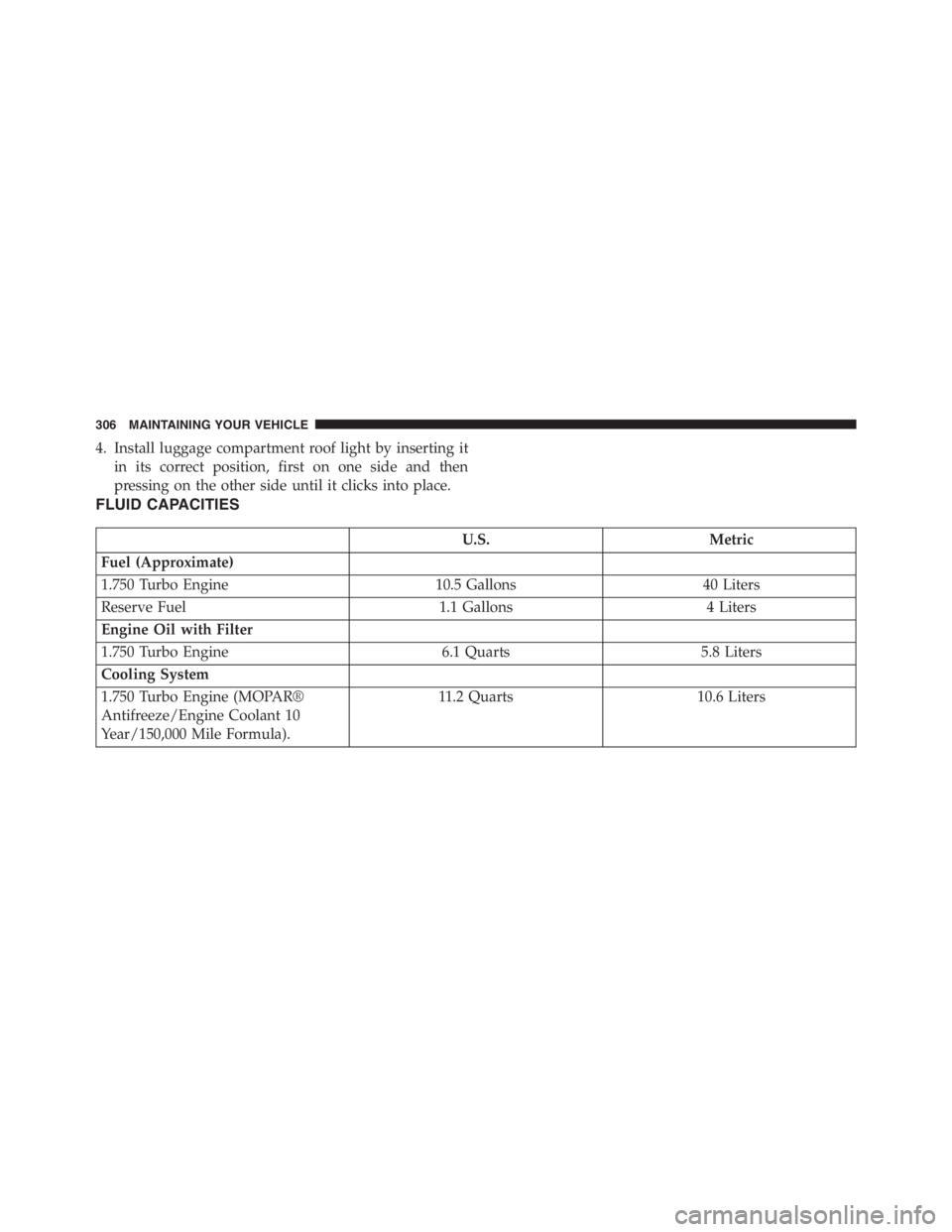
4. Install luggage compartment roof light by inserting it
in its correct position, first on one side and then
pressing on the other side until it clicks into place.
FLUID CAPACITIES
U.S. Metric
Fuel (Approximate)
1.750 Turbo Engine 10.5 Gallons 40 Liters
Reserve Fuel 1.1 Gallons 4 Liters
Engine Oil with Filter
1.750 Turbo Engine 6.1 Quarts 5.8 Liters
Cooling System
1.750 Turbo Engine (MOPAR®
Antifreeze/Engine Coolant 10
Year/150,000 Mile Formula).11.2 Quarts 10.6 Liters
306 MAINTAINING YOUR VEHICLE
Page 309 of 348

FLUIDS, LUBRICANTS AND GENUINE PARTS
Engine
Component Fluid, Lubricant, or Genuine Part
Engine Coolant - 1.750 Turbo Engine We recommend you use MOPAR® Antifreeze/Coolant
10 Year/150,000 Mile Formula OAT (Organic Additive
Technology) or equivalent meeting the requirements of
Chrysler Material Standard MS.90032.
Engine Oil - 1.750 Turbo Engine We recommend you use SAE 5W-40 API Certified
Synthetic Engine Oil, meeting the requirements of
Chrysler Material Standard MS-12991. Refer to your
engine oil filler cap for correct SAE grade.
Engine Oil Filter - 1.750 Turbo Engine We recommend you use MOPAR® Engine Oil Filter.
Spark Plugs - 1.750 Turbo Engine We recommend you use MOPAR® Spark Plugs. *
Fuel Selection - 1.750 Turbo Engine Use Only 91 Octane or higher.
7
MAINTAINING YOUR VEHICLE 307
Page 316 of 348
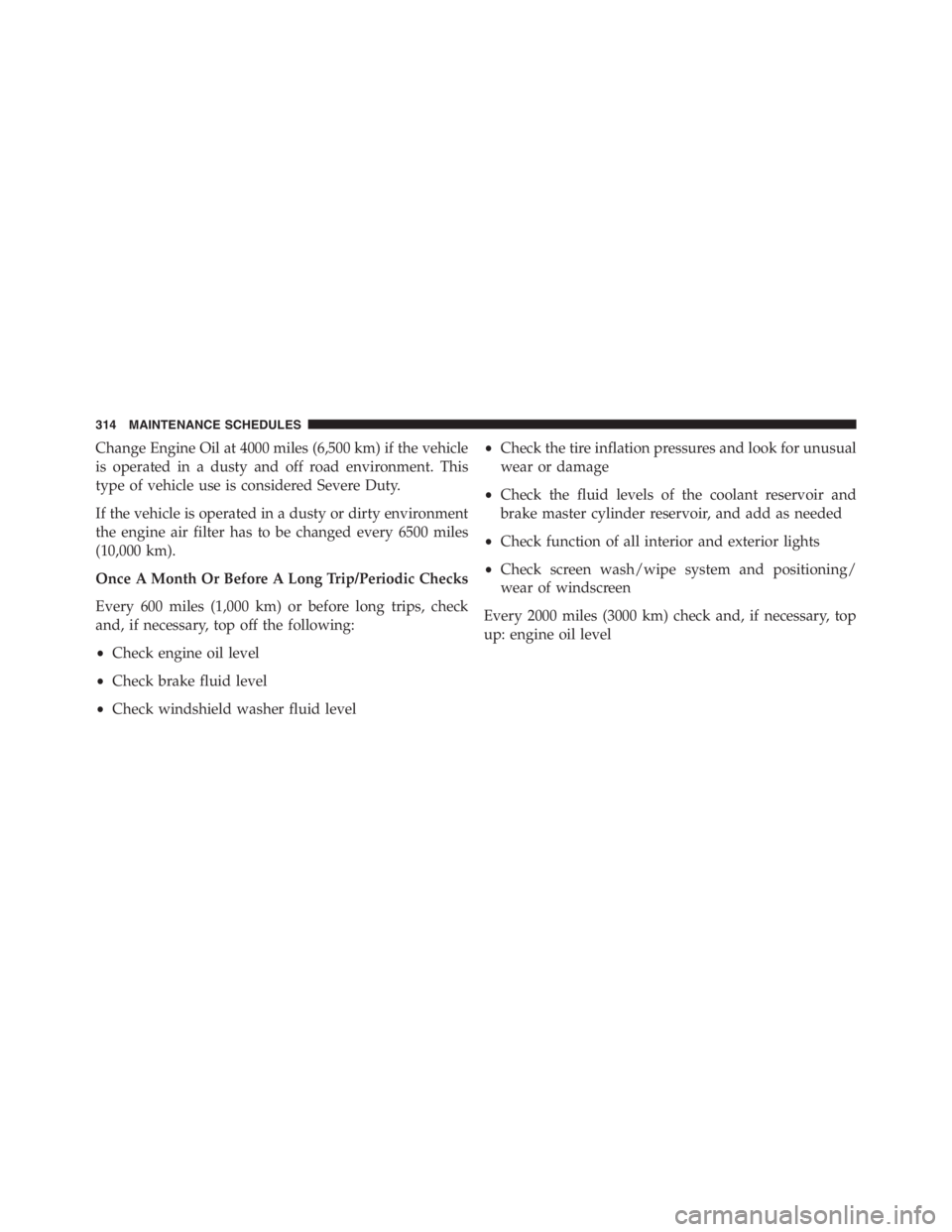
Change Engine Oil at 4000 miles (6,500 km) if the vehicle
is operated in a dusty and off road environment. This
type of vehicle use is considered Severe Duty.
If the vehicle is operated in a dusty or dirty environment
the engine air filter has to be changed every 6500 miles
(10,000 km).
Once A Month Or Before A Long Trip/Periodic Checks
Every 600 miles (1,000 km) or before long trips, check
and, if necessary, top off the following:
•Check engine oil level
•Check brake fluid level
•Check windshield washer fluid level•Check the tire inflation pressures and look for unusual
wear or damage
•Check the fluid levels of the coolant reservoir and
brake master cylinder reservoir, and add as needed
•Check function of all interior and exterior lights
•Check screen wash/wipe system and positioning/
wear of windscreen
Every 2000 miles (3000 km) check and, if necessary, top
up: engine oil level
314 MAINTENANCE SCHEDULES
Page 319 of 348

Mileage or time passed (whichever comes first)
12,000
24,000
36,000
48,000
60,000
72,000
Or Months: 12 24 36 48 60 72
Or Kilometers:
20,000
40,000
60,000
80,000
100,000
120,000
Check cleanliness of hood and deck lid locks, as well as cleanli-
ness and lubrication of associated linkagesXX X X X X
Visually inspect condition of: exterior bodywork, carbon monocoque,
aerodynamic bottom, pipes and hoses (exhaust, fuel supply system,
brakes), rubber elements (boots, driveshaft boots, sleeves, bushes,
etc.)XX X X X X
Check condition and wear of front brake pads and discs, and op-
eration of pad wear indicatorXX X X X X
Check condition and wear of rear brake pads and discs, and opera-
tion of pad wear indicatorXX X X X X
Check and top off, if required, fluid levels (engine coolant, brake/
hydraulic clutch fluid, windscreen washer fluid, battery fluid, etc)XX X X X X
Visually inspect the condition of accessory drive belt(s) X
8
MAINTENANCE SCHEDULES 317
Page 334 of 348
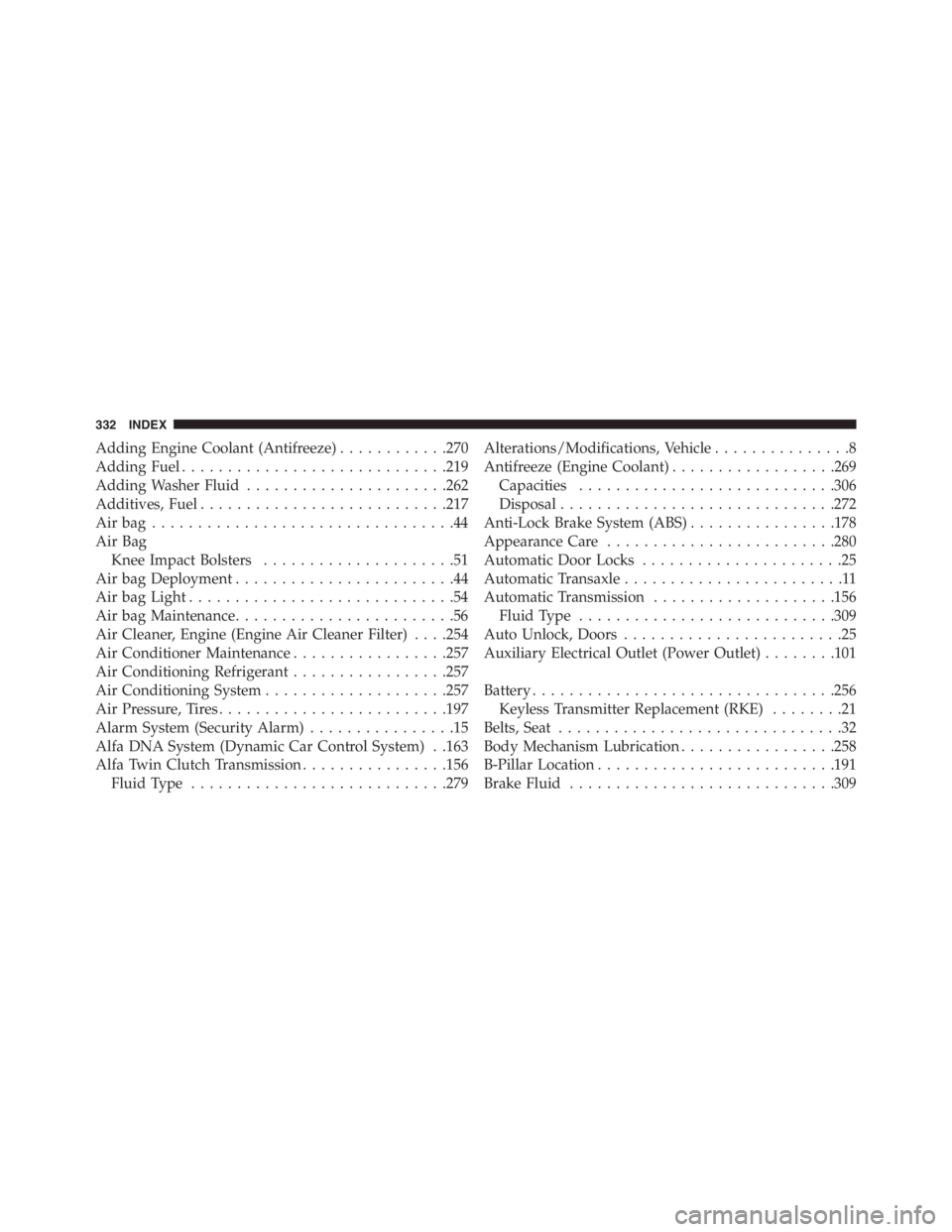
Adding Engine Coolant (Antifreeze)............270
Adding Fuel.............................219
Adding Washer Fluid......................262
Additives, Fuel...........................217
Airbag.................................44
Air Bag
Knee Impact Bolsters.....................51
Air bag Deployment........................44
Air bag Light.............................54
Air bag Maintenance........................56
Air Cleaner, Engine (Engine Air Cleaner Filter). . . .254
Air Conditioner Maintenance.................257
Air Conditioning Refrigerant.................257
Air Conditioning System....................257
Air Pressure, Tires.........................197
Alarm System (Security Alarm)................15
Alfa DNA System (Dynamic Car Control System) . .163
Alfa Twin Clutch Transmission................156
Fluid Type............................279Alterations/Modifications, Vehicle...............8
Antifreeze (Engine Coolant)..................269
Capacities............................306
Disposal..............................272
Anti-Lock Brake System (ABS)................178
Appearance Care.........................280
Automatic Door Locks......................25
Automatic Transaxle........................11
Automatic Transmission....................156
Fluid Type............................309
Auto Unlock, Doors........................25
Auxiliary Electrical Outlet (Power Outlet)........101
Battery.................................256
Keyless Transmitter Replacement (RKE)........21
Belts, Seat...............................32
Body Mechanism Lubrication.................258
B-Pillar Location..........................191
Brake Fluid.............................309
332 INDEX
Page 335 of 348
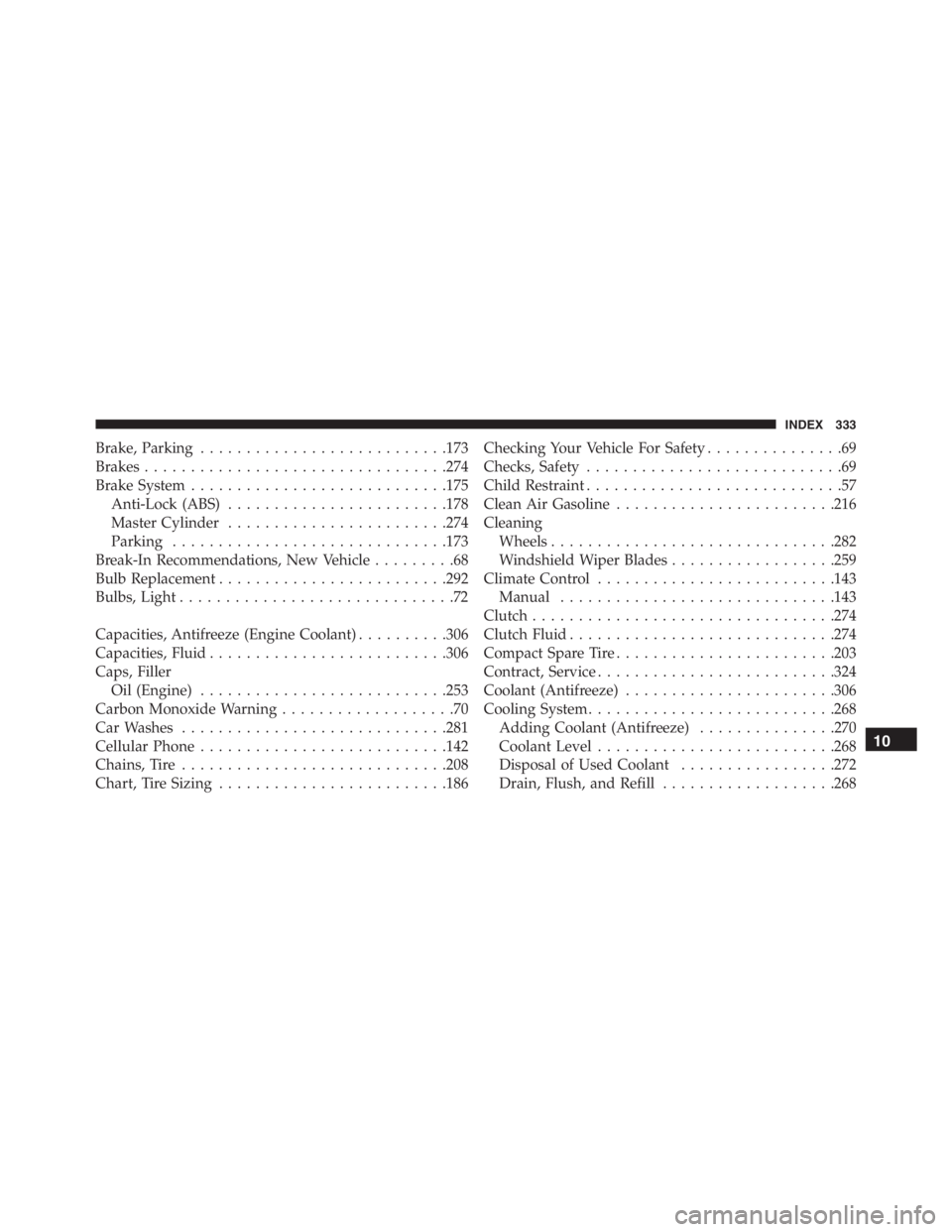
Brake, Parking...........................173
Brakes.................................274
Brake System............................175
Anti-Lock (ABS)........................178
Master Cylinder........................274
Parking..............................173
Break-In Recommendations, New Vehicle.........68
Bulb Replacement.........................292
Bulbs, Light..............................72
Capacities, Antifreeze (Engine Coolant)..........306
Capacities, Fluid..........................306
Caps, Filler
Oil (Engine)...........................253
Carbon Monoxide Warning...................70
Car Washes.............................281
Cellular Phone...........................142
Chains, Tire.............................208
Chart, Tire Sizing.........................186Checking Your Vehicle For Safety...............69
Checks, Safety............................69
Child Restraint............................57
Clean Air Gasoline........................216
Cleaning
Wheels...............................282
Windshield Wiper Blades..................259
Climate Control..........................143
Manual..............................143
Clutch.................................274
Clutch Fluid.............................274
Compact Spare Tire........................203
Contract, Service..........................324
Coolant (Antifreeze).......................306
Cooling System...........................268
Adding Coolant (Antifreeze)...............270
Coolant Level..........................268
Disposal of Used Coolant.................272
Drain, Flush, and Refill...................268
10
INDEX 333
Page 336 of 348
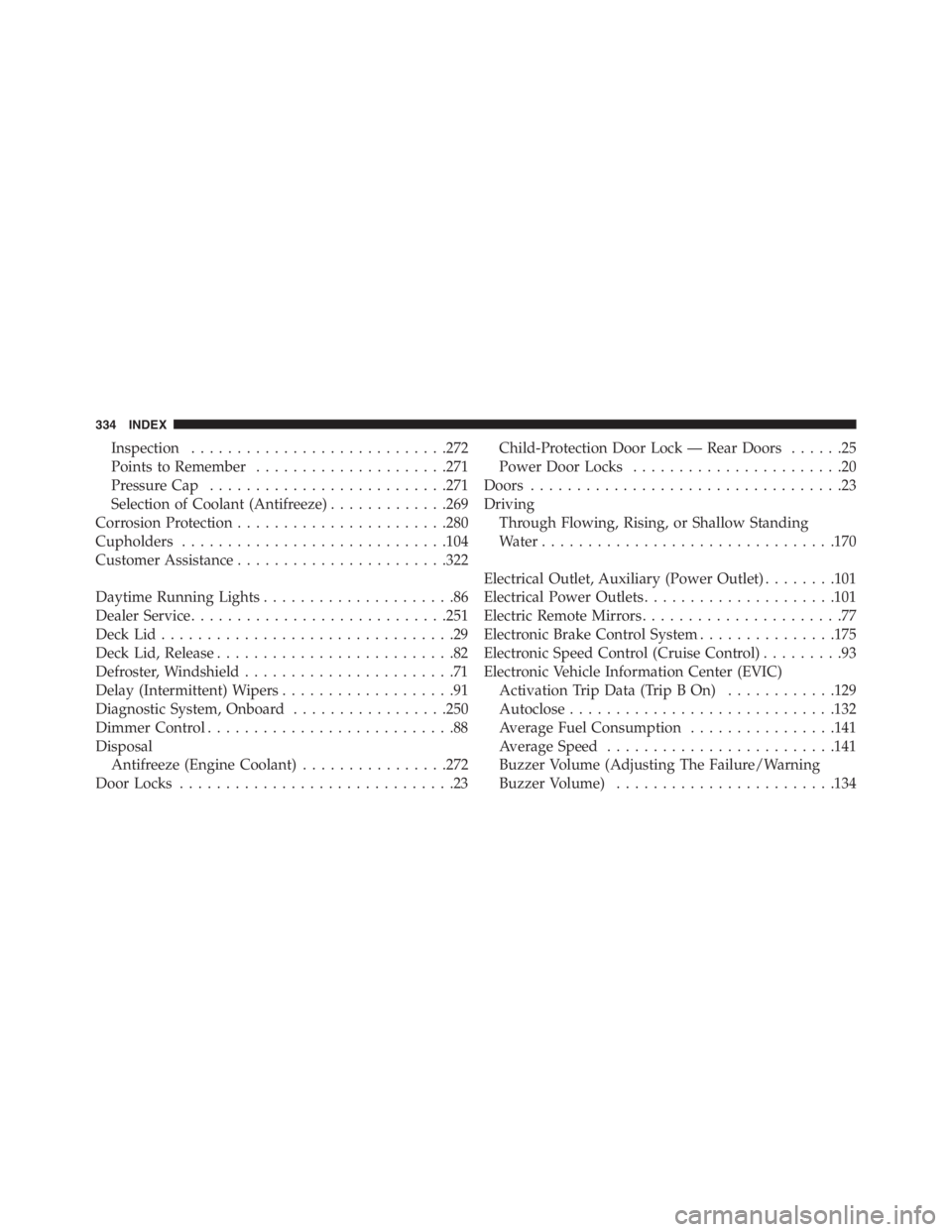
Inspection............................272
Points to Remember.....................271
Pressure Cap..........................271
Selection of Coolant (Antifreeze).............269
Corrosion Protection.......................280
Cupholders.............................104
Customer Assistance.......................322
Daytime Running Lights.....................86
Dealer Service............................251
Deck Lid................................29
Deck Lid, Release..........................82
Defroster, Windshield.......................71
Delay (Intermittent) Wipers...................91
Diagnostic System, Onboard.................250
Dimmer Control...........................88
Disposal
Antifreeze (Engine Coolant)................272
Door Locks..............................23Child-Protection Door Lock — Rear Doors......25
Power Door Locks.......................20
Doors..................................23
Driving
Through Flowing, Rising, or Shallow Standing
Water................................170
Electrical Outlet, Auxiliary (Power Outlet)........101
Electrical Power Outlets.....................101
Electric Remote Mirrors......................77
Electronic Brake Control System...............175
Electronic Speed Control (Cruise Control).........93
Electronic Vehicle Information Center (EVIC)
Activation Trip Data (Trip B On)............129
Autoclose.............................132
Average Fuel Consumption................141
Average Speed.........................141
Buzzer Volume (Adjusting The Failure/Warning
Buzzer Volume)........................134
334 INDEX